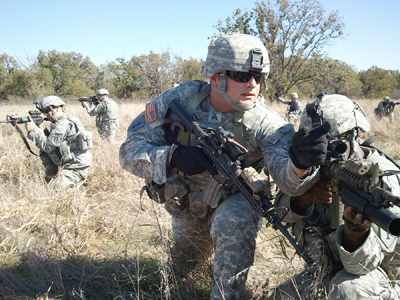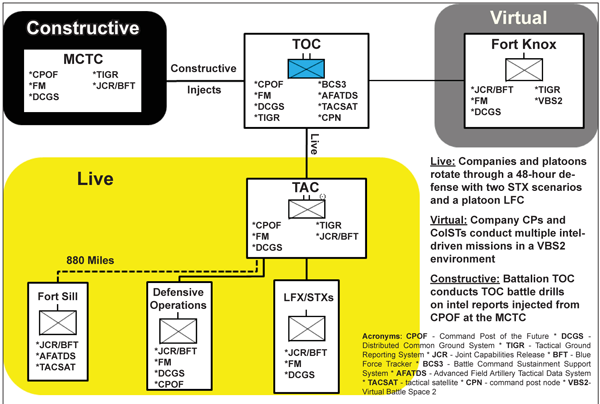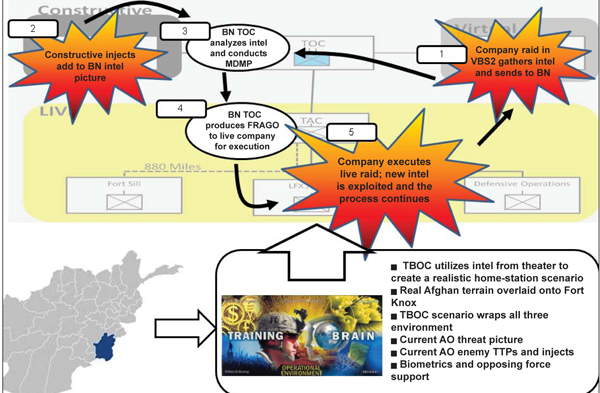Ramrod Trials: How to Plan, Resource, and Execute a Live, Virtual, Constructive Battalion FTX
by LTC Eric P. Lopez and 1LT Leslie D. Tableman

An Infantryman with the 2nd Battalion, 2nd Infantry Regiment shows another Soldier his sector of fire during an exercise at Fort Sill, Okla., in November 2012. (Photo by SGT Toby Cook)
Upon entering the train-ready phase of the Army Force Generation (ARFORGEN) model in the fall of 2012, leaders in the 2nd Battalion, 2nd Infantry Regiment, 3rd Brigade Combat Team, 1st Infantry Division, set out to plan and execute one of the most comprehensive and challenging field training exercises (FTX) in the unit’s history. The purpose of the FTX was to prepare the unit for a combat training center (CTC) rotation and follow-on deployment while simultaneously testing the battalion staff and serving as the culminating training certification event for the unit’s collective training. Ramrod Trials, as the event was named, was a multi-echelon training event that maximized limited training time by simultaneously training and assessing individual, crew, collective, staff, and leader tasks in a live, virtual, and constructive (LVC) environment. In order to maximize realism, we used near, real-time data from Afghanistan (30 days old) adjusted to the Fort Knox, Ky., training environment to build a scenario that drove the training event. Those lessons we learned during the planning, resourcing, and execution of Ramrod Trials are relevant for other units attempting to conduct similar home-station training events. The purpose of this article is to consolidate those lessons learned.
The Scenario is the Key
Ramrod Trials was based on an overarching tactical scenario influenced by injects from LVC environments. Injects from each of the environments served as events that command posts (CPs) at the battalion and company levels had to process and manage. For example, in one component of the training event, a platoon on the situational training exercise (STX) lane conducted a key leader engagement (KLE), received information on an improvised explosive device (IED) facilitator, and passed that information to its company intelligence support team (CoIST). The CoIST processed the significant activities (SIGACT) report and passed it to the battalion S2. Simultaneously, a separate platoon fighting in the virtual environment received intelligence on a different IED facilitator and passed that information to its CoIST. The CoIST processed the SIGACT and passed it to the battalion S2. At this point, the battalion S2 should be able to check this intelligence in his database and see that both IED facilitators are from the same IED cell. A skilled S2 will make this observation and pass the information to the battalion S3 for action. Building a realistic scenario that fused injects from all three environments was very hard, but it served to produce a CTC-like atmosphere at our home station. It also allowed us to simultaneously train our squads, platoons, company CPs, and battalion tactical operations center (TOC).
Planning and Resourcing (the Road to Ramrod Trials)
Planning was the key to ensure we met all the goals of Ramrod Trials. It involved months of coordinating with and leveraging as many enablers as possible to help reduce the cost of the training. Our battalion leveraged resources that were available on Fort Knox such as the Mission Command Training Center (MCTC), the Counter-IED Integration Cell (CI2C), range control, and the Special Troops Battalion (STB), while also reaching outside of Fort Knox to the Training Brain Operations Center (TBOC) and members of the Joint Expeditionary Team (JET) for support. Collaborating with local agencies was crucial to the success of the FTX because we needed space, equipment, and other resources to create the virtual and constructive components of the training. Additionally, this collaboration enabled us to incorporate IED simulators into the lanes and attach human intelligence (HUMINT) teams to platoons as they conducted key leader engagements. Additionally, utilizing outside resources allowed us to incorporate more real-world information within our training scenario. Ramrod Trials would not have been possible without the enablers.
Mission Command Training Center
The MCTC provided us with the ability to conduct virtual and constructive missions while also supporting our CoISTs as they performed their intelligence analysis. The MCTC facility reserved nearly half of its building for us to utilize over a two-week period, which included 24 hours of access to their secure building. Additionally, the MCTC offered a closed secret internet protocol router (SIPR) network for the battalion to work on. Without a closed SIPR network, the data that TBOC was able to pull from Paktika Province in Afghanistan and bent to Fort Knox would not have been utilized. It was crucial to our scenario that a closed SIPR network be created to execute the mission. The MCTC also provided the Joint Conflict and Tactical Simulation (JCATS) boxes that facilitated the scenario injects and allowed us to conduct puckster training to validate the battalion TOC.
Counter-IED Integration Cell
CI2C was a local resource that we connected with very early in the planning stages of the FTX. CI2C focuses on the IED threat that Soldiers face during deployment. CI2C provided IED simulators that were used in the live environment, and they were key contributors in training our CoISTs in the months prior to the battalion FTX.
Range Control
Fort Knox Range Control was probably the most crucial enabler to the FTX. Working in collaboration with members of range control, we were able to secure multiple pieces of land as well as move land during the exercise when unforeseeable issues arose. Additionally, range control took responsibility for creating the surface danger zones (SDZs) for our lanes once we had secured the land.
Special Troops Battalion
The STB provided the HUMINT teams that will be attached to our battalion during deployment. This allowed Soldiers who will be working together downrange to train together while in garrison and provided a foundation of trust for when the unit deploys. The HUMINT teams ran the STX lanes with our Infantry platoons and worked with the CoISTs to help them decipher intelligence reports and to create effective debriefing questions that maximize the amount of intelligence gained.
Training Brain Operations Center
TBOC, initially created as the Joint Training Counter-IED Operations Integration Center (JTCOIC) in 2008, works under the direction of the TRADOC G2 to provide quick and accurate replications of the current operational environment in LVC training events. We identified our most likely future deployment location in Afghanistan and utilized the TBOC resources to pull data from that location to create a training scenario. Because we believed that Paktika would be our future area of operation (AO), TBOC spent weeks pulling recent SIGACTs and current network information to build a scenario with the same SIGACTs and names that our battalion would encounter in Paktika. TBOC also provided three of their own analysts to assist with the execution of the FTX to ensure the scenario evolved throughout the two week period.
Joint Expeditionary Team
JETs are part of the Joint Center of Excellence (JCOE) within the Joint IED Defeat Organization (JIEDDO). JIEDDO’s mission is three-fold: defeat IEDs, attack IED networks, and train coalition forces. JETs help accomplish the training aspect of JIEDDO’s mission by providing recently deployed teams to advise and mentor deploying units. Members of JET helped us retrain platoons after they completed their lanes. JET members walked the platoon lanes in order to provide feedback to the platoons. JET was brought in to give Soldiers a brief on the newest enemy TTPs coming out of Afghanistan and provide additional advice on counter-IED training based off of the most recent enemy TTPs.
Ramrod Trial Execution
Live Environment
Within the live training environment, platoons conducted a live-fire exercise (LFX), an STX, a deliberate defense, and a fire support coordination exercise (FSCX). While the majority of the battalion conducted this training at home station, Alpha Company deployed to Fort Sill, Okla., and participated in the 75th Fires Brigade FSCX. All the exercises were supported through intelligence reports that were provided through collaboration with the TBOC which bent the Afghanistan data to Fort Knox.
- LFX – Platoons conducted a mounted deliberate attack on multiple objectives on one of the multipurpose training ranges on Fort Knox. Platoons had to integrate 60mm and 120mm mortars along with AH-64 attack helicopters in their attack.
- STX – Units conducted two STX lanes
- Companies per-formed a deliberate defense to interdict enemy moving through the area in order to build trust with the village in which their platoons would later conduct KLEs.
- Platoons conducted a dismounted patrol to a village to conduct KLEs which varied from friendly to hostile based on intelligence reports and the platoon’s approach to the KLE.
- 75th Fires Brigade FSCX – Alpha Company performed a deliberate defense and platoon attacks during which leaders coordinated fires from the Multiple Launch Rocket System (MLRS), 155mm artillery, 105mm artillery, 120mm mortars, 60mm mortars, and Kiowa scout weapons teams.
Virtual Environment (Gaming)
Company CPs and CoISTs were given a battalion operation order (OPORD). Company leaders then had to conduct troop leading procedures (TLPs), rehearsals, and then fight their mission using the Virtual Battle Space 2 (VBS2) gaming system. VBS2 was first fielded in 2009 with the intention of providing company level and below realistic training based on lessons learned from Iraq and Afghanistan. In VBS2, the companies conducted follow-on missions driven by intelligence. The virtual environment was a great tool to test company-level operations when reports came into the company CP, were analyzed by their CoIST and then disseminated to platoons. Platoons then conducted raids on high value individuals (HVIs) that were identified by their CoIST within the virtual environment. Additionally, intelligence gathered during the fight in VBS2 drove company operations later in the live environment.
Constructive Environment
JCATS provided the constructive backbone for Ramrod Trials. JCATS is a multi-purpose tool designed to support force-on-force combat training. Each day, the company tasked with support provided a white cell who “pucked” events in JCATS to stimulate the battalion TOC. This allowed the TOC to validate battle drills, improve knowledge management, and refine the TOC standard operating procedures (SOP). The TOC had to process injects from all three environments and analyze the data to build an updated intelligence picture.
Lessons Learned
At the conclusion of Ramrod Trials, leaders in the unit identified three major areas that could have improved the exercise: scenario, FTX schedule, and risk mitigation.
Scenario – Enemy Situation
Using current “real-world” intelligence to build the scenario for the FTX is not as important as building an unclassified scenario that is usable by all and can drive targeting for the CoISTs. Because the scenario built by TBOC was secret, it was almost unusable by the companies outside of the CoISTs. For example, the scenario had the names of actual enemy HVIs, and we could not release these names to our Soldiers. The right way to do it is to have an outside organization (like the brigade military intelligence company or the MCTC) build a fictional and unclassified scenario that spans all three environments and allows companies and battalion to truly conduct lethal and non-lethal targeting throughout the FTX. Ideally, this unclassified scenario would still be developed on Afghanistan terrain, enabling leaders throughout the organization to increase their familiarity with their most likely future AO.
Scenario – Higher Command
During Ramrod Trials, there was no higher command in the scenario. Therefore, we did not have to coordinate with or react to a higher headquarters (HQ). There should have been a higher HQ that provided injects to our battalion TOC (OPORDS, fragmentary orders, commander’s update briefings, battle rhythm events, etc). There are two ways to simulate a higher command in an FTX. Either the MCTC can “play” the part of brigade or the brigade can provide a mission command cell for the exercise. If implemented correctly, the personnel serving as the higher command could also achieve their own training objectives during the conduct of the exercise.
FTX Schedule
As an internally-resource simulation training event, the Battalion staff was responsible for running the FTX and participating in the exercise. This turned out to be a monumental task and both the scenario and the support of the FTX suffered because it was too much for our staff. Structuring the FTX into three major components, outlined below, would have helped mitigate this challenge:
- First four days – Standing up the FTX. This allows the staff to concentrate on supporting all the training nodes and ensuring the FTX is running well before diving into the scenario.
- Second four days – Full LVC integration into the scenario. During this period, the staff is focused on fighting the battle like a CTC (battle rhythm, lethal/non-lethal targeting, military decision-making process, etc). The staff is truly fusing intelligence from all three environments.
- Last four days – Preparation for FTX closeout. Because we were fighting the tactical scenario until the last day of the FTX, we struggled closing ranges, turning in ammunition, and recovering our vehicles and equipment.
Risk Mitigation
Because Ramrod Trials was so decentralized, it was a high-risk event. Simultaneously, we had platoons conducting LFXs, STXs, and counter-IED training all across Fort Knox and Fort Sill. During the FTX, we had two serious incidents: a vehicle rollover and a mixing of live/blank ammo. To mitigate risk in a decentralized operation, leaders must place a high priority on risk mitigation and give very clear guidance on their expectations for the mitigation of risk at each location. Additionally, leaders must inspect each location to ensure that the proper risk mitigation is occurring. In other words, leaders must help station officers-in-charge (OICs) visualize what can go wrong and then advise them on how to prevent problems at their station. The station OICs (junior leaders) must take this guidance, build their composite risk management worksheets, and actively implement the controls they identified to mitigate risk at their stations. All of this work should culminate in a risk mitigation tactical exercise without troops (TEWT) prior to the training event, where the battalion commander inspects the risk mitigation plan of each site with the site OIC prior to the training event.
Conclusion
There are four reasons why the leaders in 2-2 IN would recommend an LVC FTX to other battalions. First, it is cost effective. As we face a future of diminishing fiscal assets in the Army, LVC training maximizes training dollars by leveraging assets from external organizations. Essentially, you are using “other people’s money” to train your Soldiers. Second, the virtual and constructive environments allow you to train on mission command tasks (from the platoon to the battalion level) effectively and realistically with very low manpower requirements. Imagine the manpower and equipment requirements to train a platoon on reacting to the enemy and reporting to its company HQs in multiple different scenarios. Using VBS2 and JCATs, the platoon leader, company HQ, and CoISTs can go through multiple scenarios without any backside support required. Third, it allows leaders to produce a CTC-like environment at home station. Many battalions simply have their TOC track the number of iterations of LFXs during their FTXs. An LVC FTX forces your TOC to run the FTX and receive and process intelligence like they will have to do at a CTC. Lastly, an LVC FTX forces your battalion to operate in a distributed environment. It forces leaders to do things simultaneously versus sequentially. This is an excellent representation of combat, and it forces leaders to have disciplined initiative or the FTX will not run effectively.
Ramrod Trials was a great training event, and we accomplished our mission to create an excellent home-station training event that would make our battalion better. We conducted scenario-based, multi-echelon training that maximized time and resources by using the virtual and constructive environments. We left Ramrod Trials better trained and ready for our CTC rotation and follow-on deployment.SFC (Retired) Matthew Golden is the target development team chief with TCM-Live Range Modernization Branch at Fort Eustis, Va. His active duty assignments included serving with the 82nd Airborne Division and 101st Airborne Division (Air Assault) and drill sergeant duty with the U.S. Army Infantry School, Fort Benning, Ga..
Figure 2 – Scenario Driven Across the LVC Environments
LTC Eric Lopez is currently serving as the battalion commander of the 2nd Battalion, 2nd Infantry Regiment, 3rd Brigade Combat Team, 1st Infantry Division, Fort Knox, Ky. His battalion is currently deployed to Zabul Province, Afghanistan. LTC Lopez has completed six combat tours to Afghanistan and Iraq. His previous assignments include serving as a rifle platoon leader and scout platoon leader with the 3rd Battalion, 502nd Infantry, Fort Campbell, Ky.; rifle platoon leader and company executive officer with the 1st Battalion, 75th Ranger Regiment, Hunter Army Airfield, Ga.; assistant G3 training officer for the 10th Mountain Division, Fort Drum, N.Y.; rifle company commander of C Company, 1st Battalion 87th Infantry, Fort Drum N.Y.; liaison officer for the 75th Ranger Regiment, Fort Benning, Ga.; aide-de-camp for the commander of U.S. Army HRC, Alexandria, Va.; battalion S3 and brigade S3 in the 3rd Stryker Brigade Combat Team, Fort Lewis, Wash; and I Corps deputy G3 training, Fort Lewis.
1LT Leslie Tableman is currently serving as the executive officer for the Military Intelligence Company (MICO) of the Special Troops Battalion (STB), 3rd BCT, 1st ID, Fort Knox. Her company is currently deployed to Zabul Province, Afghanistan. This is 1LT Tableman’s first combat tour to Afghanistan. Her previous assignments include serving as the assistant S2, 2nd Battalion, 2nd Infantry Regiment, and all-source analysts platoon leader, MICO, STB — both with the 3rd BCT, 1st ID.

 Share on Facebook
Share on Facebook email
email print
print
